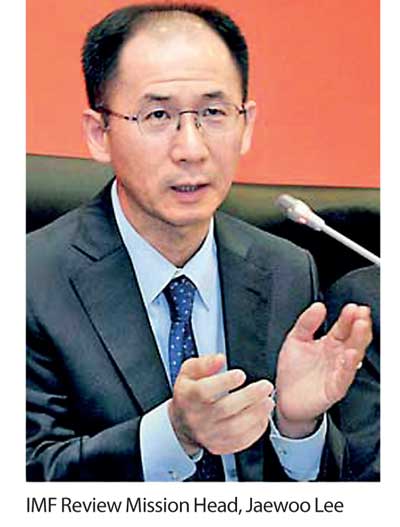14 Dec 2016 - {{hitsCtrl.values.hits}}
 The International Monetary Fund (IMF) last week revised down its full year growth targets set for the Sri Lankan economy to 4.5 percent and 4.8 percent for 2016 and 2017 respectively, from the earlier more positive projection of 5.0 percent as the multilateral lender sees the country susceptible to external vulnerabilities.
The International Monetary Fund (IMF) last week revised down its full year growth targets set for the Sri Lankan economy to 4.5 percent and 4.8 percent for 2016 and 2017 respectively, from the earlier more positive projection of 5.0 percent as the multilateral lender sees the country susceptible to external vulnerabilities.
According to IMF’s mid-term projections, the growth would only pick up to 4.9 percent in 2018 before crossing 5.0 percent mark to record 5.1 percent growth in the gross domestic product only in 2019.
IMF believes such depleted growth, particularly in 2016, would stem from the strong services sector activities and revival of construction activities. But economists have recently cast their doubts over the sustainability of such activities going forward.
The more conservative revised projections for the Sri Lankan economy from the IMF come at a time when the foreigners exiting the country’s treasury bonds in response to a widely expected hike in the benchmark treasury yield in the United States at its policy meeting scheduled to be held today.
“We are not saying the growth will fall to 4.0 percent but we are saying the growth will be slightly lower below 5.0 percent (towards) mid 4.0 percent or rather 4.5 percent”, said the IMF Mission Chief, Jaewoo Lee. The IMF’s projections for the economy are also slightly below the over 5.0 percent growth projected for the economy by the country’s Central Bank.
Sri Lanka’s economic growth slowed to 2.6 percent in the second quarter due to floods damaging the agriculture and manufacturing but is expected to have gathered steam in the second half. Lee addressing the Sri Lankan press from the Washington, D.C. via a live teleconferencing in the aftermath of the completion of the first post programme review by the IMF Executive Board said, the downward revision is mainly in response to the unfavourable external market conditions, particularly the flight of capital from the emerging markets with the expectation of a likely hike in US Treasury yields.
“External environment is not favourable as we used to think. This is the main reason for the slightly downward revision of GDP growth range.”
Capital flow volatility has certainly picked up in many emerging markets including Sri Lanka”, he said in response to a question.
Foreign holdings of Sri Lankan government securities (G-Secs) have declined by over Rs.45 billion since the beginning of October when it reached a peak for this year due to renewed optimism over the US $ 1.5 billion 3- year deal the country struck with the IMF in June.
Foreign holdings in G-Secs fell below Rs.271.3 billion on December 6 from Rs.320 billion on October 13.
Since end of October, Sri Lanka’s gross foreign reserves have also come under pressure as the reserve strength has depleted by US $ 695 million to US $ 5.3 billion within a month. The official reserves at October end was US $ 6.1 billion.
“In particular the recent developments in international reserves could put some pressures on Sri Lanka’s external vulnerability. Even at a moderate pace, reserves have been falling since October despite they need to be accumulated further through direct purchases to keep Sri Lanka’s vulnerability to external pressures,” Lee added.
Foreign holdings in Sri Lanka’s government securities significantly fell after the Central Bank’s surprise cut in policy rates by 50 basis points in April last year to spur growth through cheaper credit.
But this cheaper credit did not sustain for too long and the authorities were forced to let the rupee float in September in the same year busting the currency from Rs.133 to Rs.147 against the US dollar. This led the country to sought IMF assistance to avert a balance of payment (BoP) crisis as foreign reserves dwindled due to excessive selling of dollars to guard the rupee.
According to Amal Sanderatne, CEO of Colombo-based Frontier Research (Pvt.) Ltd, a continuous depletion of reserves over US $ 2.0 billion within a period of less than two years could put pressure on the interest rates and the currency as seen in economic cycles in the recent past.
“The reserves in the economy are one indicator that gives us a pretty good idea. Every time the reserves fall more than US $ 2 billion, we’re in trouble. This has steadily happened, whether they (politicians) deny we’re in trouble, whether in 2008, 2011 or more recently,” Sanderatne told a recent forum
26 Nov 2024 8 minute ago
26 Nov 2024 46 minute ago
26 Nov 2024 2 hours ago
26 Nov 2024 2 hours ago
26 Nov 2024 2 hours ago